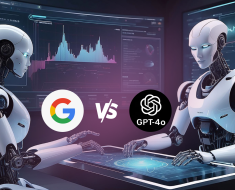Introduction
Artificial intelligence has evolved beyond expectations with LLMs like ChatGPT. GPT-4, an advanced language model, stands as the cornerstone of this technological evolution. In the age of AI-driven decision-making, understanding the contrasting realms of data and decision pipelines is fundamental. This article aims to shed light on the symbiotic relationship between technology, decision-making, and the transformative potential of GPT-4 in reshaping conventional paradigms.

Learning Objectives:
- Understand the difference between data pipelines and decision pipelines.
- Learn to leverage GPT-4 in decision pipelines.
- Learn to maximize the efficiency of GPT-4 through prompt tuning.
What is Data-Driven Decision Making?
Data-Driven Decision Making (DDDM) is an approach to making informed choices and solving problems based on data analysis and evidence. In DDDM, data is collected, analyzed, and used to guide decision-making processes across various domains, including business, healthcare, education, government, and more. This approach emphasizes the importance of relying on data and empirical evidence rather than intuition or gut feelings.

Data Pipelines vs. Decision Pipelines
The fundamental difference lies between data pipelines and decision pipelines. A data pipeline is predominantly focused on transforming data from one format to another using a mix of Python and SQL. Conversely, a decision pipeline is more about automated decision-making based on data. It often entails a blend of Python and a large language model like GPT-4.
Real-World Applications: Decision Pipelines with ChatGPT
In real-world business applications, GPT-4’s decision-making prowess is evident. For instance, using the model in sales decision pipelines has been incredibly productive. A case in point could be reaching out to potential customers via email. Through an automated process, GPT-4 can sift through the responses, identifying prospects from disinterested parties and crafting appropriate follow-up emails.

An exemplary use case for decision pipelines is the application of GPT-4 in determining the best customer from a database. This process involves generating a structured query to extract pertinent data, filtering through the database, and delivering accurate responses based on the criteria specified.
Furthermore, another intriguing example is employing GPT-4 in the realm of dating apps. By sending profile details and receiving messages to the model, one can seek assistance in discerning whether an individual matches desired preferences, consequently automating actions based on GPT-4’s response.
Text classification, a long-standing challenge in Machine Learning (ML), has been substantially eased with LLMs like GPT-4. Traditionally, ML solutions required comprehensive datasets and meticulous training to perform sentiment analysis, for instance. However, with GPT-4, it’s simplified. You can ask the model directly by asking it to determine whether the text is positive or negative, significantly reducing the conventional labeling process.

GPT-4 proves to be an exceptional solution for summarization tasks or natural language-based database interactions. Moreover, it works beautifully in decision pipelines, aiding businesses in automating responses, sales, or specialized queries within constraints.
Challenges, Security Concerns, and Model Trustworthiness
Despite its incredible utility, GPT-4 does have its limitations. Notably, it faces challenges when confronted with exceedingly complex scenarios or when handling unfamiliar information. The key to leveraging GPT-4 effectively lies in the art of prompt tuning. Crafting prompts that are precise, unambiguous, and aligned with the desired outcome is essential. It’s a journey of trial and error, refining instructions to guide GPT-4 towards the expected responses and actions.

Security is a paramount concern when employing language models for decision-making. Best practices involve refraining from sending sensitive or private data through these models, as their training process often involves multiple sources of information. Even with enterprise versions of ChatGPT, exercising caution in data inputs remains essential. Instances like Samsung’s proprietary code controversy underscore the need for vigilance regarding the data shared.
Future of Programming Influenced by ChatGPT
The advent of GPT-4 has revolutionized how language models are perceived in programming. Transfer learning architectures have been successfully implemented, enabling users to fine-tune models according to specific datasets or objectives. Besides, as language models continue to evolve, they are becoming smarter and more adept at different tasks, even assisting in evaluating ML models or providing guidance for better results.

Looking ahead, the impact of ChatGPT on the evolution of programming is noteworthy. By cutting down coding time, GPT-4 brings a paradigm shift in the development process, minimizing syntax-related struggles. As an AI-driven aid, it accelerates coding efficiency by offering code snippets or frameworks aligned with the developer’s conceptual inputs. This advance is projected to reshape the way programmers interact with code, streamlining and enhancing productivity.
Retrieval Augmented Generation: Transforming ChatGPT for Specific Company Data
Retrieval Augmented Generation, or RAG, is the current sweetheart of the industry. Essentially, RAG involves creating a ChatGPT that is well-versed in a company’s specific data. At our company, we’ve been developing a ChatGPT that understands our company-specific information. It delves into our database, effortlessly sifts through documents, and generates accurate responses to queries, offering our team an efficient solution.
Conclusion
Embracing GPT-4 for decision pipelines has unveiled an era of streamlined processes, influencing text classification, programming, and real-world applications. Despite its limitations, its remarkable abilities transcend the ordinary, defining a new standard in AI-enabled decision-making.
Key Takeaways:
- GPT-4 is invaluable in decision pipelines, enabling nuanced responses and automated decision-making, be it in sales, customer profiling, or filtering databases.
- Despite limitations in context length, strategic prompt tuning maximizes GPT-4’s precision in decision-making, warranting concise and clear instructions.
- ChatGPT’s influence on programming foresees expedited coding, reduced syntax struggles, and efficient code generation, altering how programmers interact with code.
Frequently Asked Questions
Ans. While LLMs like Claude 2 claim similar performance, none match GPT-4’s consistency, making it the prime choice for multifaceted applications.
Ans. To ensure security, avoid feeding sensitive data into models. Enterprise versions offer more privacy but exercising caution remains crucial.
Ans. GPT-4 simplifies ML tasks by directly analyzing text, reducing labeling complexities. Despite context limitations, it excels in decision pipelines and automated responses.
About the Author: Tyler Suard
Tyler’s journey reads like a tech legend. With a stellar career spanning Apple, Meta, and contributions to Fortune 500 titans like PepsiCo, Boeing, eBay, and LinkedIn, he’s a true visionary. Tyler’s skills are not just exceptional; they’re off the charts, placing him among the top 5% in LinkedIn’s Machine Learning Skills Assessment. Tyler currently works as an Artificial Intelligence Engineer and OpenAI Consultant at Parker Hannifin.
DataHour Page: https://community.analyticsvidhya.com/c/datahour/building-complex-systems-using-chatgpt
LinkedIn: https://www.linkedin.com/in/tyler-suard-14637856/





